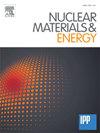液态金属脆化对氧化铝成形马氏体钢的影响
IF 2.7
2区 物理与天体物理
Q1 NUCLEAR SCIENCE & TECHNOLOGY
引用次数: 0
摘要
在低氧环境下(~ 10-11 wt% O溶解在Pb中),采用慢应变速率测试(SSRT),在350-550℃和150-550℃范围内,分别在液态Pb和铅铋共晶(LBE)中观察到铝形成马氏体(AFM)钢的液态金属脆化。在这两种环境下都可以观察到总失效伸长率(TEF)的显著下降,LBE在150°C时产生的最低TEF为0.9%应变。断裂伸长率遵循经典的延性下降模式,随着测试温度的升高逐渐恢复,因此在550℃时完全恢复延性行为。通过调整奥氏体化、淬火和回火条件来优化组织,有可能提高AFM合金的性能。本文章由计算机程序翻译,如有差异,请以英文原文为准。
Effects of liquid metal embrittlement on an alumina forming martensitic steel
Liquid metal embrittlement was observed in an alumina-forming martensitic (AFM) steel tested in both liquid Pb and lead–bismuth eutectic (LBE) in the temperature range 350–550 °C and 150–550 °C, respectively, using slow strain rate testing (SSRT) in a low oxygen environment (∼10-11 wt% O dissolved in Pb). A significant decrease in the total elongation to failure (TEF) could be observed in both environments, with LBE yielding the lowest measured TEF of 0.9 % strain at 150 °C. The elongation to failure followed the classic pattern of a ductility dip, gradually recovering with increasing testing temperature so that fully ductile behaviour was restored at 550 °C. There may be a potential to improve the performance of the AFM alloy by optimizing the microstructure through adjustments to the austenitizing, quenching and tempering conditions.
求助全文
通过发布文献求助,成功后即可免费获取论文全文。
去求助
来源期刊

Nuclear Materials and Energy
Materials Science-Materials Science (miscellaneous)
CiteScore
3.70
自引率
15.40%
发文量
175
审稿时长
20 weeks
期刊介绍:
The open-access journal Nuclear Materials and Energy is devoted to the growing field of research for material application in the production of nuclear energy. Nuclear Materials and Energy publishes original research articles of up to 6 pages in length.
 求助内容:
求助内容: 应助结果提醒方式:
应助结果提醒方式:


